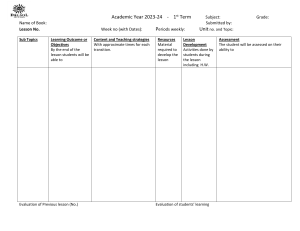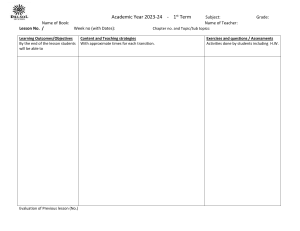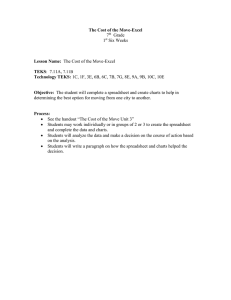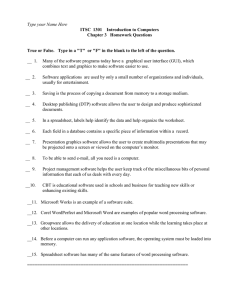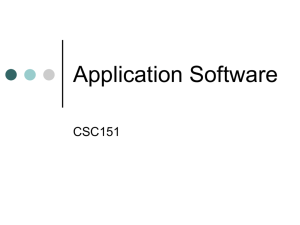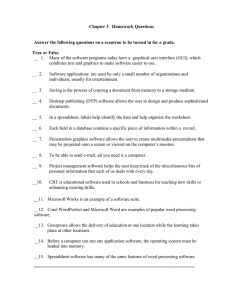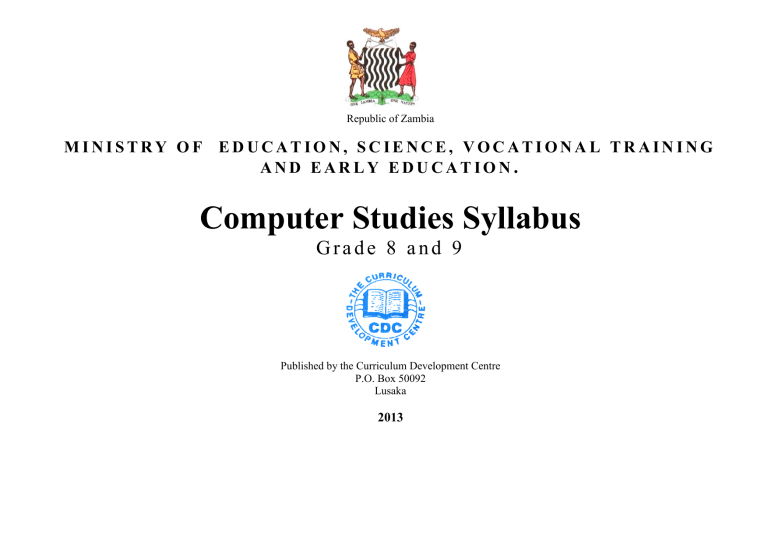
Republic of Zambia MINISTRY OF EDUCATION, SCIENCE, VOCATIONAL TRAINING AND EARLY EDUCATION. Computer Studies Syllabus Grade 8 and 9 Published by the Curriculum Development Centre P.O. Box 50092 Lusaka 2013 © Curriculum Development Centre, 2013 All rights reserved. No part of this publication may be reproduced, stored in a retrieval system, or transmitted in any form or by any means, electronic, mechanical, photocopying, recording or otherwise without prior written permission of the Publisher -2- VISION Quality, lifelong education for all which is accessible, inclusive and relevant to individual, national and global needs and value systems. -3- PREFACE The syllabus was produced as a result of the Curriculum review process carried out by the Ministry of Education, Science, Vocational Training and Early Education under the auspices of the Curriculum Development Centre (CDC). The curriculum reform process started way back in 1999 when the Ministry of Education commissioned five (5) curriculum studies which were conducted by the University of Zambia. These studies were followed by a review of the lower and middle basic and primary teacher education curriculum. In 2005 the upper basic education National survey was conducted and information from learners,parents,teachers, school managers, educational administrators,tertiary institutions traditional leaders civic leaders and various stakeholders in education was collected to help design a relevant curriculum ,. The recommendations provided by various stakeholders during the Upper Basic Education National survey of 2005 and National symposium on curriculum held in June 2009 guided the review process. The review was necessitated by the need to provide an education system that would not only incorporate latest social, economic, technological and political developments but also equip learners with vital knowledge, skills and values that are necessary to contribute to the attainment of Vision 2030. The syllabus has been reviewed in line with the Outcome Based Education principles which seek to link education to real life experiences that give learners skills to access, criticize analyze and practically apply knowledge that help them gain life skills. Its competences and general outcomes are the expected outcomes to be attained by the leaners through the acquisition of knowledge, skills, techniques and values which are very important for the total development of the individual and the nation as a whole. Effective implementation of Outcome Based Education requires that the following principles be observed: clarity of focus, Reflective designing, setting high expectations for all learners and appropriate opportunities. It is my sincere hope that this Outcome Based syllabus will greatly improve the quality of education provided at Grade 8 and 9 level as defined and recommended in various policy documents including Educating Our Future`1996 and the `Zambia Education Curriculum Framework `2013. Chishimba Nkosha Permanent Secretary MINISTRY OF EDUCATION,SCIENCE, VOCATIONAL TRAINING AND EARLY EDUCATION. -4- Acknowledgement The syllabus presented here is a result of broad-based consultation involving several stakeholders within and outside the education system. Many individuals, institutions and organizations were consulted to gather their views on the existing syllabus and to accord them an opportunity to make suggestions for the new syllabus. The Ministry of Education wishes to express heartfelt gratitude to all those who participated for their valuable contributions, which resulted in the development of this syllabus. The Curriculum Development Centre worked closely with other sister departments and institutions to create this document. We sincerely thank the Directorate of Teacher Education and Specialized Services, the Directorate of Planning and Information, the Directorate of Human Resource and Administration, the Directorate of Open and Distance Education ,the Examinations Council of Zambia, the University of Zambia, schools and other institutions too numerous to mention, for their steadfast support. We pay special tribute to co-operating partners especially JICA and UNICEF for rendering financial technical support in the production of the syllabus. C.N.M Sakala (Mrs) Director-Standard and Curriculum MINISTRY OF EDUCATION, SCIENCE,VOCATIONAL TRAINING AND EARLY EDUCATION -5- TABLE OF CONTENTS PREFACE ................................................................................................................................................................................................................................................ - 4 Acknowledgement .................................................................................................................................................................................................................................... - 5 Introduction .............................................................................................................................................................................................................................................. - 8 Time and Period Allocation: .................................................................................................................................................................................................................... - 8 GRADE 8 ............................................................................................................................................................................................................................................... - 11 8.1 Introduction to Computer Studies .............................................................................................................................................................................................. - 13 - 8.2 Basic Operations......................................................................................................................................................................................................................... - 14 - 8.3 Computers in everyday life ........................................................................................................................................................................................................ - 16 - 8.4 Productivity Tools (Word Processing) ....................................................................................................................................................................................... - 18 - 8.5 Productivity Tools (Spread Sheets) ............................................................................................................................................................................................ - 20 - 8.6 Productivity Tools (Desktop publishing) ................................................................................................................................................................................... - 22 - 8.7 Networks .................................................................................................................................................................................................................................... - 24 - 8.8 Multimedia Files........................................................................................................................................................................................................................... - 26 - GRADE 9 ............................................................................................................................................................................................................................................... - 27 9.1Introduction to Computers ................................................................................................................................................................................................................. - 29 9.2 Basic Operations......................................................................................................................................................................................................................... - 29 - 9.3 Information technology in everyday life .................................................................................................................................................................................... - 31 - 9.4 Productivity Tools (Word Processing) ....................................................................................................................................................................................... - 33 - 9.5 Productivity Tools (Spread Sheets) .............................................................................................................................................................................................. - 35 - -6- 9.6 Productivity Tools (Desktop publishing) ................................................................................................................................................................................... - 37 - 9.7 Networking & the Internet.......................................................................................................................................................................................................... - 37 - 9.8 Multi media files......................................................................................................................................................................................................................... - 39 - Terminologies ......................................................................................................................................................................................................................................... - 40 GRADES 8 TO 12 COMPUTER STUDIES SCOPE AND SEQUENCE ................................................................................................................................................... 1 -7- Introduction Suggested Teaching MethodologyThis first ever Computer Studies (CS) syllabus for Zambia offers a wide perspective of the subject. It is not restricted to computers but rather usage and application of a variety of technologies and its impact on society. The nature of the CS subject is such that it will best be learnt within the context of application. As such, activities, projects and problems that replicate real life should form an integral part of the teaching and learning methodologies. The junior secondary computer studies syllabus is meant to prepare learners for the world of work, further education within the discipline and simply lifelong learning. Since CS is extremely dynamic and also significantly always impacting on the way we live, learners should be encouraged to grapple with its complexities if they are to become competitive citizens in today’s globalised world. The assessment framework in this syllabus should utilise various types of continuous assessment strategies. This is meant to determine learners’ competences in the CS outcomes presented here. It is desired that the teacher as much as possible utilise assessment strategies that promote active learning by the learner. The case in point include portfolios, observation sheets (to gauge certain competences), written assignments and reports, presentations, projects and experiments The indicator of the achievement of these General outcomes will be based on acquisition of the skills through Assessment of the learner’s competence on practical outcomes. Time and Period Allocation: This syllabus covers a two-year course in Computer Studies and will require at least four 40 minute periods per week to complete (one doublefor practical and two single periods for theory). Sequence of the syllabus does not necessarily dictate the order in which topics are to be taught. Assessment Scheme Computer Studies is a practical subject and as such this syllabus places a lot of emphasis on the use of common application packages as well as object oriented programming languages. It will therefore be the schools’ responsibility to ensure that relevant equipment and facilities needed by learners to meet the minimum requirements for assessment purposes are acquired. There will be two modes of assessments namely: Theory and a practical. Thus the examination of Computer Studies will be divided into two sections. 1. Theory (external assessment by the examinations board): 60% 2. Practical (Paper 2) (External – Examination board): 40% 3. -8- PAPER 1 PAPER 2 PERCENTAGE SKILLS (%) Knowledge 15 Report Comprehension 5 System Product Application 10 Demonstration (Presentation) Analysis 5 Synthesis 10 Evaluation 15 TOTAL 60 TOTAL SKILLS -9- PERCENTAGE (%) 15 20 5 40 Rationale Computer Studies is about how computers compute -it is not about learning how to use the computer. It is much more than computer programming. Computer Studies is the study of ways of representing objects and processes. It involves defining problems; analysing problems; designing solutions; and developing, testing, and maintaining programs. The term computer studies refers to the study of computer science, meaning computer and algorithmic processes, including their principles, hardware and software designs, their applications, and the impact they have on society. The major focus of this subject is the development of programming skills, which are important for success in future postsecondary studies. Computer Studies is relevant for all students because it incorporates a broad range of transferable problem-solving skills and techniques, including logical thinking, creative design, synthesis, and evaluation. It also teaches generically useful skills in such areas as communication, time management, organization, and teamwork. Computer Studies will provide students with the knowledge and skills to understand the underpinnings of current computer technology and prepare them for emerging technologies. A foundation in this discipline will introduce students to the excitement and opportunities afforded by this dynamic field and will begin to prepare them for a range of rewarding careers. The subject will build a strong foundation for those who wish to move on to further study and training in specialized areas such as computer programming, database analysis, computer science, education, computer engineering, software engineering, information technology, and game development. General Outcomes Computer Studies is relevant for all students because it incorporates a broad range of transferable problem-solving skills and techniques, including logical thinking, creative design, synthesis, and evaluation. Computer Studies teaches generically useful skills in such areas as communication, time management, organization, and teamwork. - 10 - GRADE 8 General Outcomes Demonstrate an understanding of the concept of safety and misuse when using technology Operate and take care of a computer and its common peripherals Use a computer to accomplish given tasks Appreciate the role computers play in everyday life. Demonstrate understanding and operating skills required for a variety of CS Communicate using appropriate multimedia to interact with others. Enable learners attain Entrepreneurship skills for survival - 11 - Key Competences Understand and apply requirements of CS ethics and security. Share their knowledge and skills through the internet Create posters and other advertisement materials for the school events. Ensure appropriate email address is used for formal communications. Carry out a detailed research programme related to computing. Collaborate and share knowledge and ideas with others. TOPIC SUB TOPIC SPECIFIC OUTCOME - 12 - KNOWLEDGE SKILLS VALUE TOPIC 8.1 Introduct ion to Computer Studies SUB TOPIC 8.1.1 Terminologies 8.1.2 Parts of a computer 8.1.3 Input-processoutput operations SPECIFIC OUTCOME 8.1.1.1 Explain the meaning of the terms hardware, software, Information, communication and communications technology 8.1.1.1 Describe the main parts of a computer 8.1.3.1 State the three basic operations in a computer system. 8.1.3.2 Identify a computer as a general purpose machine that operates under different sets of instructions for various uses 8.1.3.3 Relate computer parts to the basic operations KNOWLEDGE - 13 - Hardware (Monitor, Keyboard, Mouse, Central Processing Unit-CPU, Uninterruptible Power SupplyUPS, printer, scanner), Software (Various programmes such as the Operating system, Word processors) Difference between data and information Computer as a general purpose machine Components of a computer system (i.e. central processing unit – CPU, input devices, storage devices & output devices) Uses of main parts of computer Advantages and disadvantages of a computer system Appreciating different types of storage media SKILLS Observation Identification of computer parts Switching on and switching off a computer system. Comparing roles of the computer parts. Connecting a computer to a power cable and peripherals Interpretation of some computer system acronyms VALUE Computer appreciation Team work in identifying parts of the computer. Safety consciousness in handling computer. TOPIC 8.2 Basic Operations 8.2.1 8.2.2 8.2.3 8.2.4 8.2.5 SUB TOPIC Health & safety Care for Computer Systems Computers & peripherals Security & Viruses Types of user interfaces SPECIFIC OUTCOME 8.2.1.1 Assume correct posture to avoid injuries. 8.2.2.1 Demonstrate the need to take care of computer and storage media to prevent data loss 8.2.3.1 Power up and down of computers and various technologies and peripherals correctly 8.2.3.2 Perform basic computer operations 8.2.4.1 Explain the consequences of theft of computers or other portable ICT devices and computer viruses. 8.2.5.1 Interact with icons and menus in a Graphic User Interface (GUI) environment. KNOWLEDGE - 14 - Assuming correct posture to avoid injuries. Safety issues associated with ICT use( e.g. securing power cables and avoiding liquids and dust near computers.) Sequence of powering up and down of various technologies(i.e. TV, cell phone, printer, scanner, etc) Basic computer operations (e.g. Moving cursor, clicking on icon, using pull-down menus, ejecting disks etc) Consequences of theft of computers or other portable ICT devices Using different types of user interfaces Pros and cons of different types of interface (command driven SKILLS Manipulation of the keyboard efficiently. Identification of home keys on the keyboard. Connecting computers to power cables and peripherals. Comparing and contrasting roles of the computer system. Securing computers VALUE Team work in identifying computer peripherals. Appreciation of antiviruses. TOPIC SUB TOPIC SPECIFIC OUTCOME - 15 - KNOWLEDGE and graphical user interfaces) SKILLS VALUE TOPIC 8.3.1 8.3 Compute rs in everyday life 8.3.2 8.3.3 8.3.4 SUB TOPIC Household, Entertainment and recreation appliances Office Equipment Industrial and Commercial Applications of computers Computer based learning SPECIFIC OUTCOME 8.3.1.1 Identify and demonstrate the use of household appliances and devices that are controlled by embedded microprocessors 8.3.2.1 State common uses of office equipment 8.3.3.1 Exhibit knowledge of using computers in Industry 8.3.4.1 Identify the role computers play in aiding learning 8.3.4.2 Identify social and economic effects of computers KNOWLEDGE - 16 - Household appliances and devices that are controlled by embedded microprocessors (e.g. Washing machines, microwave ovens, digital watches & cameras) Common uses of office equipment (Computers, Printers, Fax machines, Telephone systems, Liquid Computer Device LCD projectors, scanners etc) Computers in Industry (e.g. chemical processing plants i.e. Indeni, Mining, Liming and Cement, beverage manufacturing / Financial institutions i.e LUSE, Health, Ticket reservation systems, defence and security etc) Computers as aids for learning (e.g. SKILLS Identification use of household appliances and devices that are controlled by embedded microprocessors Manipulation of computer related appliances. Demonstration of use of household appliances and devices that are controlled by embedded microprocessors. Identification of social and economic effects of computers VALUE Appreciation of use of computer in industries and home. Skilfulness in using computers in everyday life. Inquisitiveness in using computers. TOPIC SUB TOPIC SPECIFIC OUTCOME - 17 - KNOWLEDGE Self placed interactive lessons that effectively use multimedia) Social and economic effects of computers (e.g. security concerns, deskilling, failure of systems, dependability on systems, human rights violation and computer misuse) SKILLS VALUE TOPIC 8.4.1 8.4 Producti vity Tools (Word Processing) 8.4.2 8.4.3 8.4.4 8.4.5 8.4.6 8.4.7 SUB TOPIC Introduction to Windows Key in and Edit Text Text Manipulation and Formatting Proof Reading Print Preview and Printing Saving Files Drawing Simple Graphics SPECIFIC OUTCOME 8.4.1.1 Demonstrate how to operate Windows 8.4.1.2 Demonstrate how to start and quit a program 8.4.2.1 Demonstrate text input, type over, insertion of words & symbols, deletion and reformatting 8.4.3.1 Demonstrate copying, deleting and moving blocks of text within a document 8.4.3.2 Illustrate the use of a clipboard 8.4.3.3 Use the undo command to reverse the effect of the last action 8.4.3.4 Use the redo command to reverse the undo action 8.4.4.1 Check the spelling of words in a document against a built-in dictionary 8.4.4.2 Describe the limitations of the spelling checker 8.4.5.1 Use the print preview and print a document 8.4.6.1 Demonstrate how to save a file to a specific location or media 8.4.7.1 Create graphics using basic graphic elements - 18 - KNOWLEDGE Starting Windows, the start button and taskbar, starting with the start menu, Familiarise with the main functions of the keyboard, shift and control keys start and quit a program Text input, type over, insertion of words & symbols, deletion and reformatting Copying, deleting and moving blocks of text within a document Clipboard ( temporary storage area in the memory) Undo command to reverse the effect of the last action Redo command to reverse the undo action Spelling of words in a document against a built-in dictionary (ie Thesaurus) SKILLS Inputting data correctly in a word processor. Icon identification of productivity tools. Manipulation of text in the word processor. Agility in typing text Text management (inputing of text, formatting of text) Accuracy in entering data in a word processor. VALUE Productivity in using word processor. Efficiency in text manipulation and editing. Effectiveness in the use of productivity tools. Entrepreneurship in using productivity tools. Appreciation of productivity tools. TOPIC SUB TOPIC SPECIFIC OUTCOME KNOWLEDGE - 19 - Limitations of the spelling checker Print preview and print a document Saving a file to a specific location or media graphics using basic graphic elements (e.g. lines, curves, sectors, polygons, circles, ovals, squares and rectangles) SKILLS VALUE TOPIC 8.5.1 8.5 Producti vity Tools (Spread Sheets) 8.5.2 8.5.3 8.5.4 SUB TOPIC Introduction to Spreadsheet. Entering and editing data Adding Formula Saving and Printing SPECIFIC OUTCOME 8.5.1.1 Demonstrate an understanding of the concept of worksheet and workbook 8.5.1.2 Explain the common features of a spreadsheet 8.5.1.3 Demonstrate the application of a spreadsheet in everyday life 8.5.2.1 Enter and manipulate data using spread sheets for a specific purpose 8.5.2.2 Illustrate the skill of entering text & numbers in specified cells 8.5.2.3 Delete and edit text and numbers in cells as required 8.5.3.1 Enter data, numbers and apply simple formula with a range not more than ten cell addresses 8.5.3.2 Design, create and modify a spread sheet for a specific purpose with a maximum of five cell addresses 8.5.4.1 Save to specified folder and print a spread sheet 8.5.4.2 Change magnification to appropriate percentage to print a given spread sheet KNOWLEDGE - 20 - Worksheet and workbook Common features of a spreadsheet (cells, formula bars) Application of a spreadsheet in everyday life (i.e. Student records, business stock, accounting, invoices) Entering and manipulating data using spread sheets Deleting and editing text and numbers in cells as required Entering text and numbers in specified cells Entering data, numbers and applying simple formula with a range not more than ten cell addresses (i.e. addition, subtraction, multiplication and division) Designing, creating SKILLS Loading of a single or more spreadsheets Switching between worksheets and between workbooks Application of addition, subtraction, multiplication and division symbols with formulae Manipulation Application of quick numerical computations Accuracy in the use of spreadsheet. Designing of a required spreadsheet. VALUE Accuracy in using spreadsheet. Appreciation of use of spreadsheet in making calculations. Quality work in the use of spreadsheet. TOPIC SUB TOPIC SPECIFIC OUTCOME - 21 - KNOWLEDGE and modifying a spread sheet for a specific purpose (using functions like sum, product, average and quotient) with a maximum of five cell addresses Saving to specified folder and print a spread sheet Changing magnification to appropriate percentage to print a given spread sheet formulae SKILLS VALUE TOPIC 8.6.1 8.6 Producti vity Tools (Desktop publishing) 8.6.2 8.6.3 8.6.4 8.6.5 8.6.6 SUB TOPIC Publishing basics and Features Pre-designed layouts or Templates Fonts Elementary Graphics Colours and Fonts Clip art/Redesigned graphics SPECIFIC OUTCOME 8.6.1.1 Define desktop publishing 8.6.1.2 Identify the two types of a publication 8.6.1.3 Compare different features of desktop publishing and word processing software 8.6.1.4 Generate frames in which text and graphics are placed 8.6.1.5 Edit the layout of a publication 8.6.2.1 Input text directly into a publication 8.6.2.2 Import text from word processing document into a publication 8.6.3.1 Apply the three elements of fonts; namely typeface, style and point size 8.6.4.1 Create graphics using basic graphic elements 8.6.5.1 Select colours for the outlines and fill of objects from the palette 8.6.5.2 Integrate Text into graphic design 8.6.6.1 Retrieve and edit predesigned graphics to compose a picture 8.6.6.2 Identify how productivity tools complement each other - 22 - KNOWLEDGE Desktop publishing (i.e. typesetting, and layout designs using desktop computers) Types of a publication (i.e. text and graphics) Features of desktop publishing and word processing software Frames in which text and graphics are placed Editing the layout of a publication Inputting text into a publication Importing text from word processing document into a publication Three elements of fonts; namely typeface, style and point size Graphics using basic graphic elements (e.g. lines, curves, sectors, polygons, circles, ovals, squares and SKILLS Identification of productivity tools. Manipulation of productivity tools Accuracy in the use of productivity tools. Loading a publishing package Switching between two or more loaded publishing packages VALUE Entrepreneurship in the use of productivity tools. Accuracy in the use of productivity tools. Teamwork in designing graphics. Quality work in using desktop publishing. Appreciation of the use of desktop publishing. TOPIC SUB TOPIC SPECIFIC OUTCOME - 23 - KNOWLEDGE rectangles) Colours for the outlines and fill of objects from the palette Integrating Text into graphic design Retrieving and editing predesigned graphics to compose a picture Identify how productivity tools compliment each other SKILLS VALUE TOPIC 8.7 Network s 8.7.1 8.7.2 8.7.3 8.7.4 8.7.5 SUB TOPIC Networking The Internet Web browsers Using search engines Email SPECIFIC OUTCOME 8.7.1.1 networking computers in different locations (i.e. share software, documents, databases & other resources) 8.7.1.2 Differentiate between Wired and wireless networks 8.7.2.1 Display proficiency in accessing information using a local area network (LAN), and a Wide area network (WAN) 8.7.2.2 Upload and download text, image, audio and video files 8.7.2.3 Illustrate ability to search the web for specific information. 8.7.3.1 Recognise web browsers as a tool to accessing web pages on the internet (e.g. Firefox, Safari, Internet Explorer etc) 8.7.3.2 Demonstrate how to open a web browser and go to specific Universal Resource Locator (URL) 8.7.4.1 Define a search engine and what it is used for 8.7.4.2 Use a search engine to look for information on the internet 8.7.5.1 Explain what email is used for KNOWLEDGE - 24 - 8.7.1.1 networ king computers in different locations (i.e. share software, documents, databases & other resources) 8.7.1.2 Differentiate between Wired and wireless networks 8.7.2.1 Display proficiency in accessing information using a local area network (LAN), and a Wide area network (WAN) 8.7.2.2 Upload and download text, image, audio and video files 8.7.2.3 Illustrat e ability to search the web for specific information. 8.7.3.1 Recogn SKILLS Connecting a network cable to a computer Accessing different media files from external storage devices and internal storage devices Launching a web browser Entering default web sites and edit the sites to different ones Retrieving (Searching) specific information from the Internet VALUE Understanding of types of ports (connection points) Appreciation of internal storage media and external storage media Appreciation that information is also stored on remote computers which require internet connection to access information TOPIC SUB TOPIC SPECIFIC OUTCOME - 25 - KNOWLEDGE ise web browsers as a tool to accessing web pages on the internet (e.g. Firefox, Safari, Internet Explorer etc) 8.7.3.2 Demon strate how to open a web browser and go to specific Universal Resource Locator (URL) 8.7.4.1 Define a search engine and what it is used for 8.7.4.2 Use a search engine to look for information on the internet 8.7.5.1 Explain what email is used for SKILLS VALUE TOPIC 8.8 Multimedia Files SUB TOPIC 8.8.1 Introduction to multimedia files 8.8.2 Graphics 8.8.3 Video and Audio SPECIFIC OUTCOME 8.8.1.1 Introduction to multimedia files. 8.8.2.1 Create a multimedia presentation incorporating visual image features (i.e. clip art, video clips, sound and animated images) 8.8.3.2 Access available databases for images, sound clips or recorded voice to support communication 8.8.3.3 Support communications by controlling the flow of a presentation (i.e. screen transitions, animating text & graphics) - 26 - KNOWLEDGE Differences between various types of media (video, sound, animations) Search for locally available multimedia files on the computer Controlling presentations using arrow keys SKILLS Loading a multimedia package Adding media clips to a presentation VALUE Value enhancing to physically challenged learners Productivity in using multimedia files. Efficiency in the use of Effectiveness in the use video and audio on the computer system. GRADE 9 General Outcomes Demonstrate an understanding of the concept of safety and misuse when using technology Operate and take care of a computer and its common peripherals Use a computer to accomplish given tasks Appreciate the role computers play in everyday life. demonstrate understanding and operating skills required for a variety of ICTS Communicate using appropriate multimedia to interact with others. Enable learners attain Entrepreneurship skills for survival - 27 - Key Competences Understand and apply requirements of ICT ethics and security. Share their knowledge and skills through the internet Create posters and other advertisement materials for the school events. Ensure appropriate email address is used for formal communications. Carry out a detailed research programme related to computing. Collaborate and share knowledge and ideas with others. TOPIC SUB TOPIC SPECIFIC OUTCOME KNOWLEDGE - 28 - SKILLS VALUE TOPIC 9.1Introduction to Computers SUB TOPIC 9.1.1 Terminology 9.1.2 Peripheral devices 9.1.3 Inputprocessoutput operations SPECIFIC OUTCOME 9.1.1.1 9.1.2.1 9.1.2.1 9.1.3.1 9.1.3.2 9.2.1 9.2 Basic Operations 9.2.2 9.2.3 9.2.4 Unresponsive computer Security & Viruses Copyright Storage media 9.2.1.1 9.2.2.1 9.2.2.2 9.2.3.1 9.2.3.2 Define the terminologies of a computer system. Connecting peripheral devices to their appropriate computer ports Recognise that the speed of a CPU is measured in Megahertz (MHz) or Gigahertz (GHz) Identify meaningful information as a result of processed input data by the computer Appreciate that certain devices are both input as well as output (e.g. touch screens) Identify how to shut down an unresponsive computer Understand why usernames and passwords are used on computers Identify and apply safety procedures, such as antivirus scans and virus checks in maintaining data integrity Know how to check the ID number for a software product Define the terms freeware, share-ware and end-user licence KNOWLEDGE Computer terminology; peripheral device PDAs, GB, MHz, GHz, BIT, BYTES, Megabytes etc SKILLS Connecting peripheral devices to their appropriate computer ports Converting of bytes into Bits and converting Bits into Bytes, Kilobytes & Megabytes Defining basic computer terminology Interpreting the various files sizes Peripheral devises Units of the processing speed and their relationship Relating file size to storage space Units of storage – BIT, Byte, Megabyte, Gigabyte and their conversions. Input, process and output devices How to rectify program failure of booting and shutting down. Shutting down unresponsive computer system. Installation and launching of Antivirus software Security issues associated with ICT use Verifying the authenticity of software Identify licensed software installed on a computer Inserting memory cards in computers, digital cameras, cell phones & related devices. Understand the difference between open source software and proprietary software Identify types of memory (Include: primary and - 29 - Converting memory size from one type to the other. Calculation of memory sizes and their implications on storage. VALUE Appreciating the various types of ports (serial, parallel & USB) Relation between processing speed and file size Appreciation of limitations of storage media regarding size Minimizing the effects of computer system failure Avoiding compromising the system integrate Enhancement of computer system Appreciating copyright laws Appreciating the vulnerability of memory cards on portable and handheld devices TOPIC SUB TOPIC SPECIFIC OUTCOME agreement 9.2.4.1 Describe the relationship between different measures of storage media capacities (i.e. kilobyte, megabyte, gigabyte) KNOWLEDGE secondary memory) - 30 - SKILLS VALUE TOPIC SUB TOPIC 9.3.1 9.3 Informati on technology in everyday life 9.3.2 9.3.3 9.3.4 9.3.5 Household appliances Computer based learning (CBL) Computers in banking and ecommerce Point of Sale Magnetic and smart cards SPECIFIC OUTCOME 9.3.1.1 9.3.1.2 9.3.1.3 9.3.2.1 9.3.3.1 9.3.3.2 9.3.3.3 9.3.3.4 9.3.4.1 Describe particular technologies being used for specific purposes in the home Illustrate, using examples, how information & communication networks create a global community (e.g. cell phones, internet, skype etc.) Demonstrate an understanding of new and emerging communication systems Identify different types of CBL software (e.g. drill practice, tutorial, simulation, problem solving etc.) Recognise the use of computers to organise, retrieve and process data Appreciate the linking of computers in different locations to enable electronic fund transfer (e.g. GIRO, NETS, Automated Teller Machines-ATMs etc.) Describe e-commerce and the process of purchasing goods and services online List advantages & disadvantages of ecommerce State common uses of KNOWLEDGE How to connect household equipment (connecting a decoder, DVD player, Hi-Fi system to a TV) How to connect office equipment (connecting LCD projectors, scanners, printers, digital cameras, cell phones to computers) SKILLS Connecting of household equipment (connecting a decoder, dvd player, Hi-Fi system to a TV) Connecting of office equipment ( connecting LCD projectors, scanners, printers, digital cameras, cell phones to computers) Making calls & Saving phone numbers on cell phones Appreciating the various communication technologies Starting a skype conversation Examples of CBL Software Signing oneself to a particular social network (email, Skype, Facebook, Twitter) Knowledge of social networks Creating, changing, editing and deleting user accounts Knowledge of directory, folders and files How to conduct online transaction Discussing the pro and cons of ecommerce Appreciate the use of bar codes Fundamental information contained on the bar code The link between the price list and the bar - 31 - VALUE Avoiding damage to household and office equipment. Maximising the use of household equipment Avoiding damage to office equipment Knowledge of record keeping Communicating using internet technologies Managing access to computer resources (stocks & price lists) Integration of Computers in other learning areas. TOPIC SUB TOPIC SPECIFIC OUTCOME 9.3.4.2 9.3.5.1 9.3.5.2 computers in the supermarket Identify the significance of using bar codes in the super market (i.e. identifying products, statistics and keeping track of sold items) Recognise the use of PIN (personal identification number) as a security measure to initiate transaction using magnetic card Describe the benefits of the trend towards cashless electronic transaction KNOWLEDGE code Security in business transactions among workers Appreciate stock management - 32 - SKILLS VALUE TOPIC SUB TOPIC 9.4.1 9.4 Producti vity Tools (Word Processing) 9.4.2 9.4.3 9.4.4 9.4.5 9.4.6 9.4.7 Keyboard skills Document setup and layout Search and replace Copying text from other document windows Pagination Page formatting Finding and file retrieval SPECIFIC OUTCOME 9.4.1.1 9.4.2.1 9.4.2.2 9.4.2.3 9.4.3.1 9.4.3.2 9.4.4.1 9.4.5.1 9.4.5.2 9.4.6.1 9.4.8.1 Exhibit mastery of the keyboard keys including function keys and touch typing Use the tab key to indent the first line of the paragraph Demonstrate competence in creating tables, inserting and deleting rows & columns Insert objects (e.g. Clip art, mathematical formula etc) Use the search command to locate specified text quickly in a document Use the search and replace command to carry out replacement of specified text quickly in a document Copy blocks of text from one document window to another Demonstrate insertion of page numbers of any given format Insert page and section breaks to organise text in a document Use the page set up command to set margins, paper size and page orientation Demonstrate ability to save file to a specified storage drive or device KNOWLEDGE SKILLS How to use function keys (F1 to F12) and combination keys Using function keys (F1 to F12) and combination keys How to create paragraphs in word processing How to create, edit and delete tables using the table insert How to Integrate clip art and mathematical formulae in word processing document Finding or searching command to locate a specified word How to use find or search command to locate a specified word Replacing a located word Correctly using the copy, cut and paste commands Inserting roman numerals and denary page numbers in a word document Inserting page breaks Inserting page margins, paper size and page orientation before printing a document Saving and saving as commands when saving a file to a specified storage external or internal storage devices Deleting a file and a folder containing files and how to retrieve a deleted file that was on on the computer from the recycle bin How to replace a located word How to use copy / cut and paste How to insert roman numerals and denary page numbers in a word document How to insert page breaks How to set page margins, paper size and page orientation before printing a document How to use save and save as when saving a file to a specified storage external or internal storage - 33 - VALUE Creating paragraphs in word processing Productivity (letter writing, minutes, assignments etc) creating, editing and deleting tables using the table insert Efficiency in the use of productivity tools. Entrepreneurship (letter and document writing, minutes, assignments etc) Effectiveness in the use of productivity tools. Integrating clip art and mathematical formulae in word processing document TOPIC SUB TOPIC SPECIFIC OUTCOME 9.4.8.2 9.4.8.3 Navigate to a particular drive and retrieve a specific file Delete file(s) and retrieve from the recycle bin KNOWLEDGE devices How to delete a file and a folder containing files and how to retrieve a deleted file on the computer from the recycle bin Import the drawn pie chart from a spreadsheet into a word processor - 34 - SKILLS VALUE TOPIC SUB TOPIC 9.5.2 9.5 Productivity Tools (Spread Sheets) 9.5.3 9.5.4 9.5.5 9.5.7 Amending a spread sheet Formatting cells Sorting data Entering and applying formula Charts SPECIFIC OUTCOME 9.5.2.1 Insert and delete columns and rows as required 9.5.3.1 Change column width and row height as required 9.5.3.2 Change number of decimal places displayed in cells as required 9.5.3.3 Change text orientation within a cell 9.5.4.1 Sort and filter data as specified 9.5.5.1 Enter data, numbers and apply more advanced formula (i.e. multiplication, sum & average functions) 9.5.6.1 Change percentage specification to print a given spread sheet 9.5.7.1 Use chart wizard to create bar, line and pie charts of selected data 9.5.7.2 Print a chart KNOWLEDGE How to draw pie chart using a spreadsheet. How to insert and delete columns and rows as required How to change column width and row height How to change decimal places in cells How to change text orientation in a particular cell or a group of cells How to apply advanced functions ( e.g. SUM, AVERAGE, IF, MAX, MIN, COUNT, COUNTA, SUMIF, ) How to change percentage specification using zoom facility How to use chart wizard How to link spreadsheet to word document using hyperlinks How to export the drawn pie chart from a spreadsheet into a word processor How to print preview - 35 - SKILLS Drawing pie chart using a spreadsheet. Linking spreadsheet to word document using hyperlinks Importing the drawn pie chart from a spreadsheet into a word processor Sorting data in a predetermined sequence Filtering of data in a spreadsheet Interpreting numerical data into graphs or charts Application of mathematical concepts. VALUE Productivity in budgeting, accounting, sales forecasting, stock management. Efficiency in using spreadsheet. Entrepreneurship in the use of spreadsheet in tracking a business. Effectiveness of spreadsheet. TOPIC SUB TOPIC SPECIFIC OUTCOME KNOWLEDGE and print How to paginate using page break preview - 36 - SKILLS VALUE TOPIC SUB TOPIC 9.6.1 9.6 Producti vity Tools (Desktop publishing) 9.6.2 9.6.3 9.6.4 9.6.5 Charts , Diagrams and pictures Text wrapping Importing Text Manipulation of predesigned templates Colours and Fonts SPECIFIC OUTCOME 9.6.1.1 9.6.1.2 9.6.2.1 9.6.2.2 9.6.3.1 9.6.3.2 9.6.4.1 9.6.4.2 9.6.5.1 9.7 Networki ng & the Internet 9.7.1 9.7.2 9.7.3 9.7.4 9.7.5 Networking The Internet Web browsers Using search engines Email 9.7.1.1 9.7.2.1 KNOWLEDGE Add charts, diagrams and pictures Edit, resize & crop charts, diagrams and pictures Demonstrate how to wrap text around charts , diagrams & pictures Generate frames in which charts, diagrams & pictures are placed Import text from other programs (word processor & spreadsheet ) Import charts, diagrams & pictures from other programs Create calendars, notices, fliers, brochures, newsletters, resumes using templates Edit manipulated templates Select colours for the outlines and fill of objects from the palette Identifying how productivity tools compliment each other Demonstrating wrapping of text around charts, diagrams & pictures List the advantages of group working (i.e. shared files, applications and printers Display understanding of the terms local area network (LAN) and Wide area network (WAN), Personal Area Network (PAN), Storage Area Network (SAN), Metropolitan Area Understanding how to generate charts, diagrams & pictures Distinguishing between importing and exporting of publications Differentiating the use of various templates Modifying created publications Enhancing objects in a publication through the use fonts & colours Managing of shareable resources (files, applications, & printers) Distinguishing various types of networks using examples (e.g. computer network, cellular network (hotspots), satellite - 37 - SKILLS Identifying pre-designed layouts or template for appropriate tasks Modifying already created publications Enhancing objects in publications Saving and printing previewing publications Sharing resources using sharing facility Deriving appropriate web addresses from institution/organisation/com pany names based on services provided (e.g. org, edu, ac, co, gov etc) Starting, refreshing and terminating web search Utilising internet VALUE Entrepreneurship in the use of Desktop publishing. Effectiveness use of Desktop publishing. Reduction in computer hardware and software costs Sourcing of information from a broader scope Reduction in communication costs through email and other free internet services. TOPIC SUB TOPIC SPECIFIC OUTCOME 9.7.2.2 9.7.2.3 9.7.3.1 9.7.3.2 9.7.3.3 9.7.4.1 9.7.5.1 9.7.5.2 Network (MAN), Wifi. Describe the difference between an intranet and an extranet Differentiate between World Wide Web and the internet Recognise components of a Universal Resource Locator (URL) Show how to stop a web page from downloading Illustrate how to refresh, move back and forward Appreciate various services available on the internet (e.g. On-line news, shopping etc.) Explain the make up and structure of an email address Send and reply to an email message KNOWLEDGE SKILLS network. Distinguishing between the two main types of Local Area Networks (Intranets & Extranets) Relating the World Wide Web (global web pages) to the Internet (technologies, infrastructure & protocols) The relationship between URL and Internet surfing Understanding the navigation patterns of web pages Appreciating the communication and information services provided by the Internet Understanding the syntax of email addresses - 38 - communication tools (Skype, twitter, facebook, Creating of an email address Sending and receiving a message through email. VALUE TOPIC SUB TOPIC 9.8.1 9.8 Multi media files 9.8.2 Digitising images Video & Audio SPECIFIC OUTCOME 9.8.1.1 Create digital images using a scanner and or a digital camera 9.8.1.2 Edit digitised images by cropping, enhancing pixels, colour etc 9.8.1.3 Saving created images 9.8.2.1 Record video & audio 9.8.2.2 Save video and audio files KNOWLEDGE Creating digital images using scanners & cameras Editing and enhancing scanned and digitised images SKILLS VALUE Creating digital images using scanners and cameras Entrepreneurship in the use of multimedia. Editing and enhancing scanned and digitised images Productivity in the use of multimedia. Efficiency in the use of multimedia. Saving images with appropriate file extensions Appropriately saving of file names and file extensions Inquisitiveness in the use of multimedia. Recording Video & Audio using digital camera & or microphone Recording video & audio using multimedia related technology Naming audio & video files with appropriate file names & extension. Naming audio and video files with appropriate file extension Appreciate the different media file extensions Understanding the syntax of media file naming - 39 - Terminologies Arithmetic and Logic Unit (ALU) Cell address Cell pointer Copy Central Processing Unit (CPU) Cursor Cut Database Desktop Publishing (DTP) Document Email Extranet File Font Graphic Icon Information technology Input device Internet Intranet LAN Menu Mouse Multimedia Navigate Output device Paste Peripheral Port Presentation Printer Programme Retrieve - 40 - Scanner Search engines Software Spell Checker Spreadsheet Storage device Telecommunication Text WAN Word processing World Wide Web - 41 - |Page 42 GRADES 8 AND 9 COMPUTER STUDIES SCOPE AND SEQUENCE The table below shows the coverage of the syllabus in Computer Studies in Grades 8and 9. It is important for a teacher to refer to this table from time to time to know the knowledge that the learners already have or need to have at various levels of learning of the subject. Introduction to Computer Studies Basic Operations Generic Application Software GRADE 8 Terminology of computer hardware. Parts of a computer Input-process-output operations GRADE 9 Terminology of a computer system. Peripheral devices Input-process-output operations Health & safety Care for Computer Systems Computers & peripherals Security & Viruses Types of user interfaces Introduction to Windows Key in and Edit Text Manipulation and Formatting Proof Reading Print Preview and Printing Saving Files Drawing Simple Graphics Keyboard skills Document setup and layout Search and replace Copying text from other document windows Pagination Page formatting Finding and file retrieval |Page 1 Systems and Communications GRADE 8 Introduction to Spreadsheet Entering and editing data Adding Formula Saving and Printing Publishing basics and Features Pre-designed layouts or Templates Fonts Elementary Graphics Colours and Fonts Clip art/Re-designed graphics Introduction to multimedia files Graphics Video and Audio Digitising images Video & Audio Types of Computer System Computer Application GRADE 9 Amending a spread sheet Formatting cells Sorting data Entering and applying formula Charts Household, Entertainment and recreation appliances Office Equipment Industrial and Commercial Applications of computers Computer based learning Charts , Diagrams and pictures Text wrapping Importing Text Manipulation of pre-designed templates Colours and Fonts Networking The Internet Web browsers Using search engines Email Household appliances Computer based learning (CBL) Computers in banking and e-commerce Point of Sale Magnetic cards and smart cards |Page 2 GRADE 8 Social and Economic Implications of the use of Computers GRADE 9 Unresponsive computer Security & Viruses Copyright Storage media Logic Gates and Circuits |Page 3
